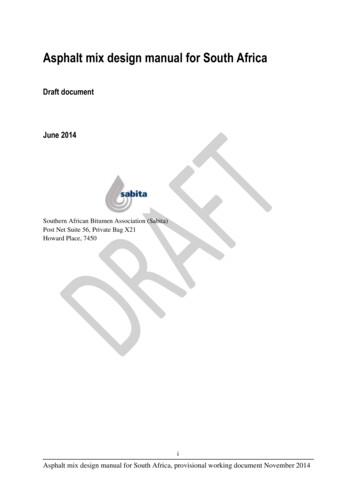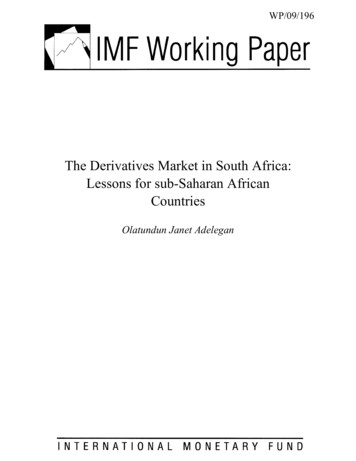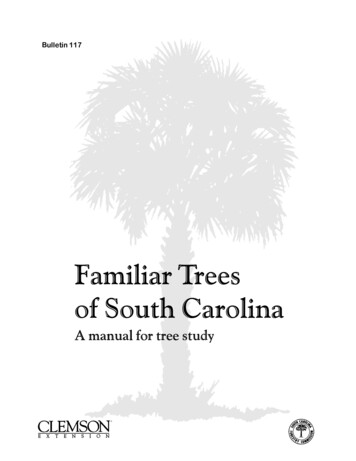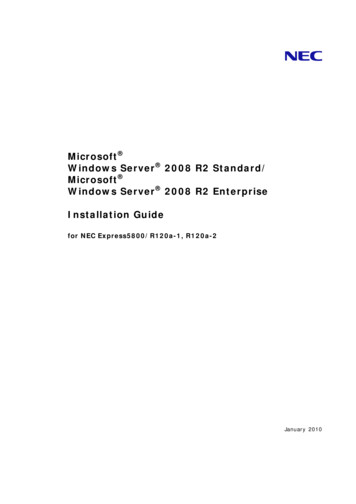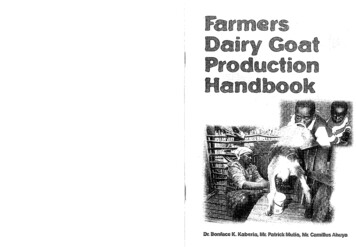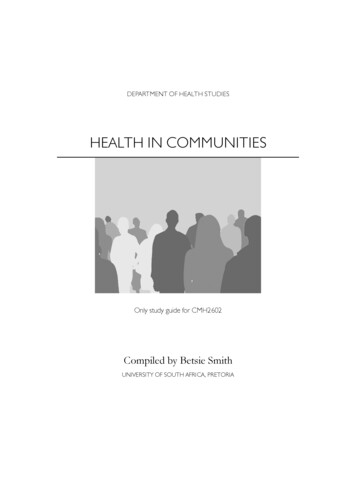
Transcription
# 2008 University of South AfricaAll rights reservedPrinted and published by theUniversity of South AfricaMuckleneuk, PretoriaCMH2602/1/2009 201198316532
(iii)ContentsWELCOME AND INTRODUCTION(vii)PART 1: THEORETICAL FOUNDATIONS IN COMMUNITY HEALTH1LEARNING UNIT 1:21.11.21.31.41.51.61.71.81.9CONCEPTS AND THEORIES/MODELS IN COMMUNITY HEALTHIntroductionTheoretical thinking as a languageChoosing a theory/model to apply to community healthThe dimensions model of community health nursingOrem's self-care deficit theory of nursingNeuman's systems model/theoryPender's health promotion modelGordon's functional health pattern frameworkConclusion22345891011PART 2: THE INDIVIDUAL AND FAMILY AS CLIENT13LEARNING UNIT ining the concept of familyStructure of the familyTypes of familiesStages of family developmentThe family as social systemCultural values in the familyFamily functionsRoles of the familyConclusionLEARNING UNIT 3:3.13.23.33.43.53.63.73.83.93.103.11THE FAMILY AS CLIENTASSESSING FAMILY HEALTHIntroductionAssessment of the familyThe biophysical dimensionThe psychological considerationsThe physical environmental considerationsThe socio-cultural dimensionThe behavioural considerationsThe health system considerationsDiagnostic reasoning and the family as a clientPlanning, implementation and 27283031313132
(iv)LEARNING UNIT 4: INFANTS FROM BIRTH TO 18 MONTHS4.1Introduction4.2Definition of child health4.3Growth and development during infancy4.4Developmental tasks4.5Infant nutrition4.6Cognitive-perceptual patterns4.7Child abuse4.8Stress in infancy4.9Pathological processes4.10 Immunisation4.11 Conclusion343434343536373738383841LEARNING UNIT 5: THE TODDLER (18 36 MONTHS)5.1Introduction5.2Age and physical changes5.3Nutrition in toddlers5.4Elimination and exercise patterns5.5Sleep and rest pattern5.6Cognitive-perceptual pattern5.7Self-perception-self-concept pattern, roles-relationships pattern, child abuse,sexuality-reproductive pattern, coping with stress, and values and beliefs5.8Pathological processes5.9Social processes5.10 Conclusion43434344444445LEARNING UNIT 6: THE PRE-SCHOOL CHILD6.1Introduction6.2Age and physical changes6.3Cognitive-perceptual patterns6.4Self-perception-self-concept pattern, roles-relationships pattern, sexuality-reproductive pattern, coping-stress pattern and values-beliefs pattern6.5Pathological processes6.6Social processes6.7Conclusion48484849LEARNING UNIT 7: THE SCHOOL-AGE CHILD7.1Introduction7.2Age and physical changes7.3Cognitive-perceptual pattern7.4Self-perception-self-concept pattern, roles-relationships pattern, sexuality-reproductive pattern, coping-stress pattern and values-beliefs pattern7.5Pathological processes and social processes7.6Conclusion52525253LEARNING UNIT 8: THE ADOLESCENT8.1Introduction8.2Age and physical changes: Gordon's functional health patterns8.3Gordon's functional health patterns in adolescents8.4Pathological processes in the adolescent8.5Social 51545555
(v)LEARNING UNIT 9: GENDER HEALTH9.19.29.39.49.59.69.7IntroductionThe status of womenWomen's health statusThe lesbian/gay, bisexual and transgender (LGBT) clientMen's health statusThe epidemiology of health for gay, bisexual and transgender menConclusionLEARNING UNIT 10: CARE OF THE CLIENT IN THE WORK SETTING10.110.210.310.410.5IntroductionThe objectives of occupational healthThe occupational health nurse's scope of practiceNursing care of working populationsConclusionLEARNING UNIT 11: THE OLDER 111.1211.1311.1411.1511.16IntroductionAge and physical changesGoals of health promotionPattern of health perception-health managementNutritional metabolic patternElimination patternActivity-exercise patternSleep-rest patternCognitive-perceptual patternSelf-perception-self-concept patternRoles-relationships patternSexuality-reproductive patternCoping-stress tolerance pattern and values-beliefs patternPathological processesSocial 8697070707070707171717171717272PART 3: THE COMMUNITY AS CLIENT75LEARNING UNIT 12: HEALTH PROMOTION IN THE 1012.1112.12IntroductionDefinition of a communityDefining the term community healthThe community as a clientGoals of community-oriented practiceStrategies for improving community healthCommunity partnershipsCommunity-focused nursing 67677777779797980818383
(vi)LEARNING UNIT 13: INTERVENTIONS FOR HEALTH PROMOTION IN THE tionDefinitions of health promotionInterventions for health promotionThe purpose of health educationThe health educatorPrinciples for health educationImplementation of the educational planEvaluation of the educational processConclusionLEARNING UNIT 14: ISSUES IN COMMUNITY Human Immunodeficiency Virus (HIV)/Acquired Immunodeficiency Syndrome (Aids)Tuberculosis (TB)PovertyHomelessnessViolenceCommunity 4959597BIBLIOGRAPHY98ANNEXURE A: FEEDBACK FOR SCENARIO IN LEARNING UNIT 3 Ð LEARNINGUNITS 4 1299ANNEXURE B: FACTS ABOUT IMMUNISATION106ANNEXURE C: THE REVISED EXPANDED PROGRAMME ON IMMUNISATION INSOUTH AFRICA (EPI-SA) SCHEDULE108ANNEXURE D: PLANS TO ADD TWO NEW VACCINES TO PREVENT PNEUMONIAAND DIARRHOEA IN BABIES110ANNEXURE E: PRIVATE VACCINES SCHEDULE111
(vii)Welcome andintroductionWelcome to this second-level module on health in communities. You will learn about theconcepts and theories/models involved in community health to equip you with a theoreticalfoundation for this module. The aim of this module is to equip you with knowledge aboutthe life span of the individual in order to give you skills to work with families in thecommunity. You will also gain a holistic approach towards critical issues in the community.You should grow and develop into a competent and skilful practitioner who can identifyneeds and problems relating to family health and respond to them in an innovative way.Working through this module will enrich your life not only professionally, but alsopersonally.The nature of this study guideThis study guide has been designed in an interactive way with the aim of guiding youthrough two prescribed books.As you work through this study guide you should integrate the information in the studyguide with the information in your prescribed books.The Internet has a wealth of information and you are advised to use the Internet as often aspossible to broaden your knowledge on certain topics.Prescribed booksYou are expected to purchase the following prescribed books for this module:Clark, MJ. 2008. Community health nursing: advocacy for population health. 5th edition.Englewood Cliffs, NJ: Prentice-Hall.Edelman, CL & Mandle, CL. 2006. Health promotion through the lifespan. 5th edition. StLouis: Mosby.Edelman and Mandle (2006) has very valuable information on health promotion and coversthe entire life span, from birth to death. In addition to your study guide, this book is veryimportant: you will find a wealth of information.Clark (2008) is a book on community health nursing that emphasises the dimensionsmodel of community health nursing right through. This is a very valuable model whichwill help you to gain a holistic and systematic approach towards the individual, family andcommunity.
(viii)The information in these two books is complementary. Together with the study guide it willhelp you to gain the knowledge and skills you will need to supply health care to individuals,families and communities.ActivitiesThe activities are planned to either reinforce content, to guide you to tackle upcomingcontent, or to motivate you to think about issues. You will note that in part 2 of the studyguide there is only one activity at the end of each learning unit: here we want you to applythe dimensions model of community health to a member of the family. Feedback on allthese activities will be given in annexure A.This CMH2602 module runs parallel with the practice module for Community Health,CMH2126. The theory cannot be separated from the practice.IconsYou will find a series of icons in the text to guide you as you progress with your studies.ActivityWhen you see this icon, you will know that you must complete an activity. We may askyou to read a specific section in the prescribed literature, apply given information, thinkabout topics that have not been introduced, find your own information or ask otherpeople for information. Please read the instructions carefully.Assessment criteriaThis icon indicates the questions that you can use to assess your own understanding ofthe work. These questions are adapted from the outcomes. You are told what youshould do to prove that you have met the learning outcomes.Prescribed readingWhen you see this icon, study or read the prescribed book as indicated, beforecontinuing with the next section.Learning outcomeThis icon tells you how you will benefit in the field of practice if you know the contentof the specific learning unit. The outcomes tell you what you will be able to do after youhave studied the work.hFeedbackThis icon tells you what was expected from you when you did the activity. It will notnecessarily give you all the facts but will give you guidelines on how to answer thequestion. Not all of the activities will have feedback because many of the answers aregiven in your prescribed books.
(ix)ConclusionThis module is designed to enable you to work with families in the community. It is basedon the needs and problems of the family. It covers individuals who are part of the family andthe family as part of the community. After completion of this module, together with thepractice module, you will be able to take responsibility for practising as an independentcommunity nurse in any community setting.
PART 1THEORETICAL FOUNDATIONSIN COMMUNITY HEALTH
2Learning unit 1Concepts and theories/models in community healthOutcomesSince theories/models provide you with the knowledge you need to practisecommunity health in a scientific way, it is essential for you to be familiar with thevarious theories/models in the field to be able to apply them to community health.When you have worked through this learning unit you will be able to:****1.1describe various concepts in theoretical thinkingexplain selected theories/models in detaildescribe the key concepts and themes of the selected theories/modelsapply the theories/models to community healthIntroductionWhile we will discuss theories/models in general in this learning unit, we will also deal withseveral selected theories in more depth in order to indicate how they can be applied tocommunity health.It is currently accepted that theories form the basis of community health. Since theoriesprovide us with the knowledge we need to practise community health in a scientific way, itis essential for the community nurse to be familiar with the various theories/models in thefield and to be able to apply them to community health.1.2Theoretical thinking as a languageThe terms theory, model, conceptual framework, conceptual model are often usedsynonymously in literature. The literature reflects various conflicting opinions about theterms, their usage and meaning. According to Polit and Beck (2008:141) a conceptual modelor a conceptual framework represents a more informal mechanism for organising anddiscussing phenomena or concepts, while theories are more formal in nature. Conceptualtheories, frameworks and models are composed of concepts or constructs. Theseconcepts or constructs are interdependent because they systematically demonstrate therelationship between variables. A model is a symbolic representation of concepts orvariables with an interrelationship. A phenomenon is the abstract concept under study, often
3used by qualitative researchers, while a concept is a description of the objects or events thatform the basis of a theory. Both models and theories can describe and predict therelationship between phenomena. Models and theories are terms that are often usedinterchangeably in literature.The term theory is often used to refer to the subject content that student nurses must betaught in the lecture room to acquire the information they need to perform the nursingtasks in practice. Researchers such as Polit and Beck (2008:768) define theory as anabstract generalisation that presents a systematic explanation about the relationshipsamong phenomena''. Theories include principles for explaining, predicting and controllingphenomena. In all disciplines theories serve the same purpose. This purpose is to makescientific findings meaningful, and to make it possible to generalise. A theory is composed ofconcepts and constructs that are systematically related and that are also goal-oriented(Stanhope & Lancaster 2006:196). Types of traditional theories include grand theories andmiddle-range theories. Grand theories describe and explain large segments of the humanexperience which are very broad. Middle-range theories explain more specific phenomenasuch as stress, self-care, health promotion and infant attachment. Metatheory is a term usedto label theory about the theoretical process and theory development (Polit & Beck2008:141).Metaparadigm refers to the main concepts that identify the phenomena or ideas of interestto a discipline, in this case the discipline of nursing. They provide the boundaries for thesubject matter of the discipline. The metaparadigm concepts for nursing include person,environment, health and nursing (Clark 2008:67). However, current literature suggests that afour-concept metaparadigm for the discipline of nursing is too limited and suggestsadditional concepts such as transitions, interaction, nursing proces
8.3 Gordon’s functional health patterns in adolescents 57 8.4 Pathological processes in the adolescent 58 8.5 Social processes 59 8.6 Conclusion 59 (iv) LEARNING UNIT 9: GENDER HEALTH 60 9.1 Introduction 60 9.2 The status of women 61 9.3 Women’s health status 62 9.4 The lesbian/gay, bisexual and transgender (LGBT) client 63 9.5 Men’s health status 63 9.6 The epidemiology of health for .
